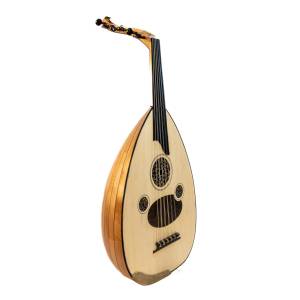Turkish Oud
As Tapadum Music Store, we are proud to present you the Turkish Ouds of Necati Gurbuz, Yıldırım Palabiyik, Feramis Aktaş and other master instrument makers who have an important place in the oud world.
Showing all 9 resultsSorted by price: low to high
-
Sale!

Turkish Oud with Maple Bowl
€439,00Original price was: €439,00.€429,00Current price is: €429,00. Add to cart -

Turkish Oud with Guitar Pegs (Black Walnut)
€549,00 Add to cart -
Sale!

Electric Oud – Electro Acoustic Turkish Oud – Easy Stage Performances
€799,00Original price was: €799,00.€699,00Current price is: €699,00. Add to cart -
Sale!

Sultan Turkish Oud
€835,00Original price was: €835,00.€799,00Current price is: €799,00. Add to cart -
Sale!

Professional Turkish Oud By Feramis Aktas Maple Body Premium Quality
€1.299,48Original price was: €1.299,48.€849,21Current price is: €849,21. Add to cart -
Sale!

Professional Cedar Top Oud with Gig Bag
€1.050,00Original price was: €1.050,00.€949,13Current price is: €949,13. Add to cart -
Sale!

Professional Turkish Oud By Feramis Aktas Padouk & Walnut
€1.399,30Original price was: €1.399,30.€1.099,00Current price is: €1.099,00. Add to cart -
Sale!

Yildirim Palabiyik Sultan Plus Oud – Premium Quality
€1.250,00Original price was: €1.250,00.€1.199,00Current price is: €1.199,00. Add to cart -
Sale!

Professional Turkish Oud By Feramis Aktas (with pick-up)
€1.499,30Original price was: €1.499,30.€1.279,24Current price is: €1.279,24. Add to cart
Turkish Oud Instruments
By focusing on these strategic areas, musicians can elevate their Turkish oud playing to professional levels, contributing richly to the tradition and evolution of this storied instrument.
a captivating fretless lute, transcends the realm of a mere instrument. It’s a cornerstone of Turkish music, weaving its magic through generations with its rich and expressive voice. This guide embarks on a journey to explore the unique characteristics, meticulous construction, and the captivating tonal qualities that have made the Turkish oud such a beloved instrument.
A Legacy Etched in Wood: A Historical Perspective
The origins of the oud stretch back millennia, with evidence suggesting its presence in ancient Mesopotamia and Egypt. Over time, the instrument evolved and journeyed across trade routes, finding a warm embrace in the Ottoman Empire. Here, the oud flourished under the patronage of Sultans, becoming a centerpiece of courtly music and intellectual discourse. Renowned oud players like Tanburi Cemil Bey and Sheikh Dede honed their craft, shaping the instrument’s role in Turkish music. Today, the Turkish oud continues to be a vital element, captivating audiences in concert halls, Sufi ceremonies, and social gatherings.
Crafting a Voice: The Anatomy of the Turkish Oud
The captivating sound of the Turkish oud is a result of its meticulously crafted design. The instrument boasts a distinctive pear-shaped body, traditionally built from hardwoods like maple, rosewood, or walnut. These meticulously chosen woods resonate beautifully, amplifying the instrument’s warm and enveloping tones. The body’s design often incorporates a subtle curvature, further enhancing the depth and resonance of the oud’s sound. This curvature allows for optimal air circulation within the instrument’s chamber, contributing to its powerful and rich voice.
A Feast for the Eyes: Aesthetic Adornments
The aesthetics of the Turkish oud are equally captivating. The instrument’s front face, known as the “göğüs” (chest), frequently features intricate carvings and decorative motifs. These exquisite details, often made of mother-of-pearl or ebony, showcase the artistry and cultural significance of the oud. Traditional motifs may include geometric patterns, floral designs, or even calligraphy, each carrying a unique story. These details transform the oud into a visual masterpiece, complementing its captivating sound and making it a true piece of cultural heritage.
Precision at Your Fingertips: The Fretwork
The frets of a Turkish oud, traditionally crafted from natural wood or bone, play a crucial role in both playability and sound quality. Unlike Western fretted instruments, the Turkish oud is fretless. This allows for a subtler and more nuanced approach to pitch, enabling musicians to explore the beauty of microtones, a defining characteristic of Turkish music. Precise fret placement markings on the fingerboard, known as “perdeler” (curtains), serve as a guide for experienced players, ensuring accurate intonation and expressive freedom.
Uniquely, some Turkish ouds feature adjustable frets made of gut or nylon. These “movable frets” (hare perdeler) can be repositioned on the fingerboard by the player, allowing for further customization of the instrument’s temperament and tonal characteristics. This innovative design provides flexibility for players, enabling them to personalize the instrument’s response and tailor it to their specific playing style and the requirements of the musical piece.
A Spectrum of Emotions: The Enchanting Sound
The soul of the Turkish oud lies in its captivating sound. Defined by a bright treble register and a rich, resonant character, the Turkish oud is capable of expressing a vast array of emotions. From the heart-wrenching sorrow of a lament, like a “ağıt,” to the joyous celebration of a festive dance, like a “curcuna,” the Turkish oud’s voice can evoke a profound spectrum of human experience. Skilled players utilize various techniques to manipulate the strings, producing a captivating repertoire of sounds. Techniques like “şelpe” (flicking), “tıklamalar” (tapping), and vibrato add depth and ornamentations to the melody.
A key contributor to the instrument’s unique sound is its capacity for microtones. Microtones are intervals smaller than the standard half-step found in Western music. The ability to play microtones is essential for capturing the essence of Turkish maqams, the melodic modes that form the foundation of Turkish music. These maqams, with their intricate quarter tones and subtle nuances, create a distinct emotional landscape that resonates deeply with Turkish audiences. Through the mastery of microtones on the Turkish oud, musicians weave intricate melodies that transport listeners on a journey through the rich tapestry of Turkish musical expression.
A Legacy Carried Forward: The Turkish Oud Today
The Turkish oud is a cherished instrument embraced by professional musicians, students, and music enthusiasts alike. Its ability to render the complexities of traditional Turkish maqams makes it an indispensable tool for preserving and transmitting this rich musical heritage. In the hands of a skilled player, the Turkish Oud becomes a powerful voice, expressing profound emotions


